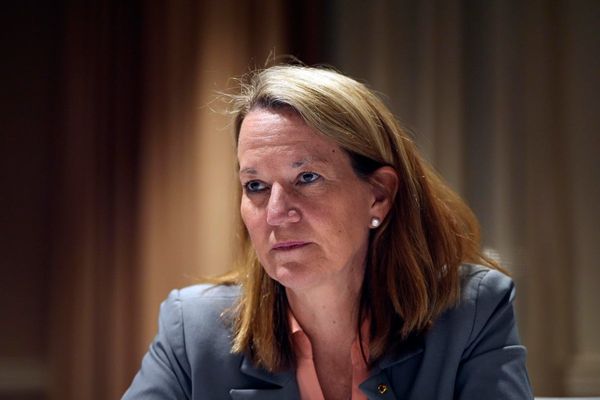It’s the next big market call that could enrich traders across Wall Street: The raging global energy crisis and ever-more hawkish central banks knock key economies into 1970s-style stagflation.
It’s a long shot for now, but anxiety is building among money managers that this market scenario — out-of-control inflation just as growth slumps — will eventually come to pass, especially in Europe.
Global growth optimism sunk to an all-time low, according to this month’s Bank of America Corp. fund manager survey. Stagflation expectations jumped to 66%, the highest since 2008. U.S. price pressures rose in March by the most since late 1981, while data Wednesday showed U.K. inflation exceeded the estimates of economists for the sixth straight month.
Money managers are increasingly prepping for bad economic news — and nowhere more so than in Europe, belying hopes coming into this year that the region will outperform the U.S. Amundi SA is prepping for a possible downturn in the continent, abrdn Plc is long the U.S. dollar against the euro and Vanguard Group Inc. is touting liquidity hedges.
Other in-vogue trades include bets on commodity exporters from Australia to Canada and wagers against bonds teeming with interest-rate risk.
A lot of bad things need to happen before an investing climate that bears the hallmarks of stagflation transpires, with European Central Bank President Christine Lagarde among those pushing back against the likelihood. A decision Thursday gives rate-setters an opportunity to debate their timetable for tightening.
But one thing’s for sure: If newbie traders have limited real-world experience with inflation, fewer still can recall a world of runaway prices just as growth tanks.
Even if stagflation-like pressures are limited to Europe, they have the capacity to hurt Wall Street traders betting on the international growth story, while evoking memories of the sovereign debt crisis and the lost-decade of growth.
The region is epicenter of concern, given its proximity to Russia’s war and weaker domestic levers for growth. German breakevens, a debt gauge of expected inflation over the next decade, have risen over one percentage point so far this year. Meanwhile prices paid to U.S. producers jumped in March from a year ago by the most in records back to 2010.
Below is a collection of money-manager views. Comments have been edited for clarity.
James Athey is a London-based investment director at abrdn, which oversees around 542 billion pounds ($707 billion) in assets. The 42-year-old is short the euro and the U.K. pound.
— “The most acute stagflation risks without doubt are in continental Europe.”
— “As the current account surplus dwindles away because of the need to import ever more expensive energy, their currency will weaken further, raising inflation and hurting the key export sectors. Or they can tighten monetary policy to try and cap inflation and support the currency, but this will crush already weak domestic demand. Either way, their growth versus inflation trade-off looks horrible.”
— “Central banks in most countries will struggle to deliver the hikes that are currently priced. The exception is most likely the U.S. Therefore we are positioned for steeper curves in Europe and flatter curves in the U.S. We are long the U.S. dollar versus the euro and sterling.”
Andrew McCaffery, the 58-year-old global chief investment officer of Fidelity International, which has $813 billion in assets. His base case is a European recession and the investor is staying away from the region’s equities and the single currency:
— “We advocate positioning for the high likelihood of stagflation in developed markets, with a base case of recession in Europe.”
— “Stagflation presents a challenge, but there are some areas within fixed income that we think will be better protected from rising rates and slowing growth. Breakevens should continue to perform relatively well, on the premise that inflation expectations will rise, and we are also constructive on euro-investment grade, given its more defensive characteristics and improved valuations.”
Henrietta Pacquement, the 45-year-old head of the global fixed income team at Allspring Global Investments, says Russia’s invasion changes the game for Europe. The London-based investor cites shorter-maturity bonds and floating-rate notes as potential stagflation hedges.
— “Stagflation is a scenario you have to contemplate. You still have upward inflation pressures as well as downward pressures on growth. Does that push economies into stagflation or even a recession at a later stage? The question is still open. We’re clearly still seeing the tailwind of the post-pandemic opening-up of the economy.”
— “There’s lot of volatility in the interest-rate market. Meanwhile, credit markets have been reasonably well behaved. We’ve seen new issues coming to the market with interesting premiums and I think that’s a trend that will continue to see periodically for the rest of the year. “
Malvern, Pennsylvania-based Arvind Narayanan, co-head of investment-grade credit at Vanguard which oversees about $8 trillion, sees higher risks of stagflation globally, with Europe facing the steepest prices pressures.
— “Central banks’ intent is to slow down inflation and the only way they can do that is by reducing aggregate demand — but that will take time.”
— “Over the last ten years, portfolios all over the world were looking for yield — going deep down credit and into global emerging market type of exposure to get that extra return to outperform. Now the world is different.”
— “You want to be underweight duration and credit exposures — and shore up your portfolios with ample liquidity because this transition is not going to be smooth.”
Lynda Schweitzer, a Boston-based portfolio manager and co-head of the global fixed income team at Loomis Sayles & Co., isn’t fully buying the stagflation story but she remains worried.
— “It’s certainly disappointing that we are marking down growth at the same time we are rising up inflation.”
— “Shortening duration in the major markets where central banks are going to be hiking and removing accommodation certainly makes sense.”
— “Another place we’ve been talking about pretty significantly is what all this means for emerging markets — for commodity-linked countries where terms of trade have increased with the increase in commodity prices.”
Akira Takei, global fixed-income money manager at Asset Management One Co. in Tokyo, also sees the biggest risk of stagflation in Europe and the U.K.
— “Rising gas prices have seen a surge in European inflation.”
— “Considering the ultra-long part of the yield curves have already flattened considerably, intermediate notes have potential to gain in the U.K. and eurozone. The BOE has been leading other central banks in rate hikes, but risks to yields are no longer one-way. I see a high chance that two- to five-year notes will start to price out Bank of England rate hikes going forward.”
— “The pound and euro are weak and will continue to be so given both are close to the epicenter of the Ukraine crisis.”
Vincent Mortier, Paris-based group chief investment officer at Amundi, which oversees more than $2 trillion in assets, favors a neutral stance on global equities and a defensive allocation to credit as Europe increasingly becomes the epicenter of stagflation risks.
— “An earnings recession is possible in Europe even before an economic recession kicks in.”
— “Weak technicals, underlined by a combination of factors such as withdrawal of central bank support, rising rates and economic growth pressure, call for a defensive allocation to credit. Continued inflation calls for a positive tilt on sensitive assets in the form of inflation-linkers bonds, gold, some real assets.”







